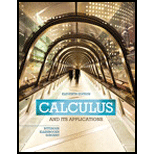
Concept explainers
Finding Natural Logarithms as Limits.
Given that the derivative of
Thus, we can define
In Exercises 54-57, use this definition to find each limit.
Want to see the full answer?
Check out a sample textbook solution
Chapter 3 Solutions
Calculus and Its Applications (11th Edition)
Additional Math Textbook Solutions
A First Course in Probability (10th Edition)
Elementary Statistics: Picturing the World (7th Edition)
Basic Business Statistics, Student Value Edition
Elementary Statistics (13th Edition)
Elementary Statistics
Algebra and Trigonometry (6th Edition)
- Find the equation of the tangent line at the given value of x on the curve. 2y3+xy-y= 250x4; x=1 y=arrow_forwardFind the equation of the tangent line at the given point on the curve. 3y² -√x=44, (16,4) y=] ...arrow_forwardFor a certain product, cost C and revenue R are given as follows, where x is the number of units sold in hundreds. Cost: C² = x² +92√x+56 Revenue: 898(x-6)² + 24R² = 16,224 dC a. Find the marginal cost at x = 6. dx The marginal cost is estimated to be $ ☐ . (Do not round until the final answer. Then round to the nearest hundredth as needed.)arrow_forward
- The graph of 3 (x² + y²)² = 100 (x² - y²), shown in the figure, is a lemniscate of Bernoulli. Find the equation of the tangent line at the point (4,2). АУ -10 10 Write the expression for the slope in terms of x and y. slope =arrow_forwardUse a geometric series to represent each of the given functions as a power series about x=0, and find their intervals of convergence. a. f(x)=5/(3-x) b. g(x)= 3/(x-2)arrow_forwardAn object of mass 4 kg is given an initial downward velocity of 60 m/sec and then allowed to fall under the influence of gravity. Assume that the force in newtons due to air resistance is - 8v, where v is the velocity of the object in m/sec. Determine the equation of motion of the object. If the object is initially 500 m above the ground, determine when the object will strike the ground. Assume that the acceleration due to gravity is 9.81 m/sec² and let x(t) represent the distance the object has fallen in t seconds. Determine the equation of motion of the object. x(t) = (Use integers or decimals for any numbers in the expression. Round to two decimal places as needed.)arrow_forward
- Early Monday morning, the temperature in the lecture hall has fallen to 40°F, the same as the temperature outside. At 7:00 A.M., the janitor turns on the furnace with the thermostat set at 72°F. The time constant for the building is = 3 hr and that for the building along with its heating system is 1 K A.M.? When will the temperature inside the hall reach 71°F? 1 = 1 hr. Assuming that the outside temperature remains constant, what will be the temperature inside the lecture hall at 8:30 2 At 8:30 A.M., the temperature inside the lecture hall will be about (Round to the nearest tenth as needed.) 1°F.arrow_forwardFind the maximum volume of a rectangular box whose surface area is 1500 cm² and whose total edge length is 200 cm. cm³arrow_forwardFind the minimum cost of a rectangular box of volume 120 cm³ whose top and bottom cost 6 cents per cm² and whose sides cost 5 cents per cm². Round your answer to nearest whole number cents. Cost = cents.arrow_forward
- Find the absolute extrema of the function f(x, y) = x² + y² - 3x-3y+3 on the domain defined by x² + y² <9. Round answers to 3 decimals or more. Absolute Maximum: Absolute Minimum:arrow_forwardFind the maximum and minimum values of the function f(x, y) = e² subject to ï³ + y³ = 128 Please show your answers to at least 4 decimal places. Enter DNE if the value does not exist. Maximum value:arrow_forwardA chemical manufacturing plant can produce x units of chemical Z given p units of chemical P and 7 units of chemical R, where: z = 140p0.6,0.4 Chemical P costs $300 a unit and chemical R costs $1,500 a unit. The company wants to produce as many units of chemical Z as possible with a total budget of $187,500. A) How many units each chemical (P and R) should be "purchased" to maximize production of chemical Z subject to the budgetary constraint? Units of chemical P, p = Units of chemical R, r = B) What is the maximum number of units of chemical Z under the given budgetary conditions? (Round your answer to the nearest whole unit.) Max production, z= unitsarrow_forward
- Algebra & Trigonometry with Analytic GeometryAlgebraISBN:9781133382119Author:SwokowskiPublisher:Cengage

 Functions and Change: A Modeling Approach to Coll...AlgebraISBN:9781337111348Author:Bruce Crauder, Benny Evans, Alan NoellPublisher:Cengage Learning
Functions and Change: A Modeling Approach to Coll...AlgebraISBN:9781337111348Author:Bruce Crauder, Benny Evans, Alan NoellPublisher:Cengage Learning  Linear Algebra: A Modern IntroductionAlgebraISBN:9781285463247Author:David PoolePublisher:Cengage Learning
Linear Algebra: A Modern IntroductionAlgebraISBN:9781285463247Author:David PoolePublisher:Cengage Learning College AlgebraAlgebraISBN:9781305115545Author:James Stewart, Lothar Redlin, Saleem WatsonPublisher:Cengage Learning
College AlgebraAlgebraISBN:9781305115545Author:James Stewart, Lothar Redlin, Saleem WatsonPublisher:Cengage Learning




